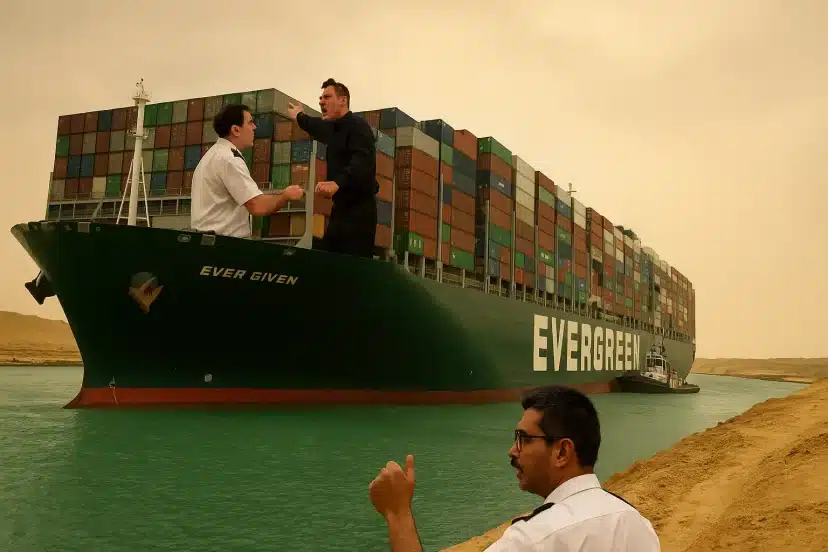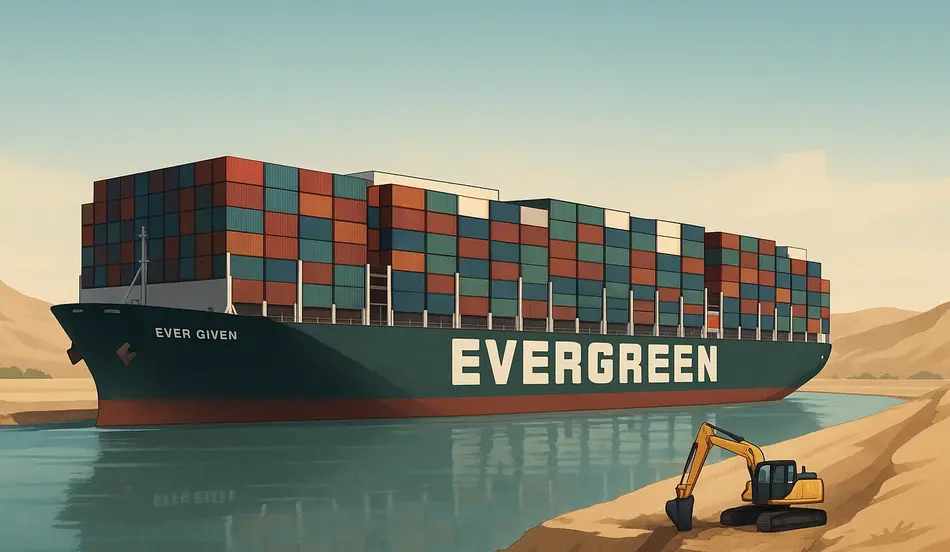The Ever Given Suez Canal Blockage in March 2021 reshaped the world’s understanding of global trade vulnerabilities.” The Ever Given—a 400-meter container ship as long as the Empire State Building is tall—ran aground in the southern section of Egypt’s Suez Canal, halting 12% of the world’s maritime trade for nearly a week.
What followed was a drama of human error, technical challenges, international legal disputes, and a race against time to restore one of the world’s busiest shipping lanes.
A Reporter on the Ground During the Ever Given Suez Canal Blockage
Matthew Campbell, a reporter and editor for Bloomberg Businessweek, was among the first international journalists to travel to Egypt to cover the incident. “Getting to Egypt was the most hassle I’ve ever had on a reporting trip,” he recalls.
Egyptian officials were reluctant to discuss the disaster, but by attending court hearings in Ismailia and speaking with canal authorities, Campbell uncovered critical details—including testimony that the Suez Canal pilots onboard the Ever Given had argued heatedly on the bridge before the crash.
How the Ship Got Stuck
Initially, Egyptian authorities blamed strong winds and a sandstorm. But as Campbell notes, “Bad weather may not be the main reason. Strong winds happen half the year in this region.”
Court evidence revealed heated disputes between the two Egyptian pilots guiding the ship. At one point, they allegedly shouted insults at each other, while the ship swerved erratically. The captain, Krishnan Kanthavel, attempted to intervene but faced a tense dynamic: under Suez Canal rules, local pilots have authority to give steering instructions, even though the captain remains responsible.
At a critical moment, one pilot reportedly ordered the vessel to go “full ahead,” accelerating to 13 knots. Instead of stabilizing the ship, the speed magnified instability due to a hydrodynamic effect called Bernoulli’s Principle, which pulls vessels toward canal banks at high speeds.
The Ever Given soon lodged both its bow and stern diagonally into the canal’s banks—completely blocking the passage.

A Global Shipping Crisis
The impact was immediate. Within 24 hours, more than 100 ships were stranded. Each day of blockage delayed $10 billion worth of goods, from oil to consumer electronics, highlighting how fragile the global supply chain truly is.
“Look around any room,” Campbell said. “The vast majority of objects you see traveled on ships. And if you live in Europe or North America, they probably passed through the Suez Canal.”
At its peak, the traffic jam stretched into the hundreds of ships, snarling schedules for weeks even after the canal reopened.
Digging, Tugging, and a Viral Meme
Initial efforts to dislodge the ship looked almost comical: a lone yellow excavator scraping at the sand beside the colossal bow. Images of the tiny digger became a viral internet meme, symbolizing both futility and determination.
Soon, professional salvage crews from Dutch firm Smit arrived. They recommended removing containers to lighten the vessel—an operation that could have taken months. Egyptian officials balked, fearing prolonged closure, and instead pursued dredging and towing operations.
The rescue relied on timing. In late March, a “supermoon” created unusually high tides, increasing buoyancy. With more powerful tugboats, dredging, and ballast adjustments, the Ever Given finally broke free on March 29, cheered on by horns and shouts of “Number one!” from the crews.
The Legal Battle
Once freed, the Ever Given was towed to the Great Bitter Lake for inspection. But the saga was far from over. The Suez Canal Authority demanded $900 million in compensation, citing salvage costs and reputational damage.
Negotiations dragged on, with the Egyptian government eventually lowering its claim to $550 million. Though the exact settlement remains undisclosed, the incident underscored how accidents in narrow waterways can spark global financial disputes.
Keep Global Trade Moving With the Right Talent
Post your job on WhatJobs and hire logistics, supply chain, and maritime professionals who ensure your business stays on course—no matter the disruption.
Post a Job Now →Lessons Learned
The Ever Given crisis exposed critical vulnerabilities in global trade:
- Overreliance on mega-ships: The vessel carried 17,000 containers, valued collectively at over $1 billion. Larger ships save costs but are harder to maneuver in narrow passages.
- Fragile chokepoints: Roughly 12% of global trade depends on the Suez Canal. One incident can paralyze entire industries.
- Tense pilot dynamics: Miscommunication and authority disputes between local pilots and captains can amplify risks.
- Global economic ripple effects: Delays cascaded through shipping schedules, leading to shortages and price spikes across industries.
A Reminder of Shipping’s Importance
Shipping often operates invisibly, far from public attention. But the Ever Given reminded the world just how dependent modern life is on fragile maritime arteries.
“For about a week, the whole world was riveted by shipping,” Campbell said. “And all it took was one wrong turn to shut it all down.”
FAQs
1. How long was the Suez Canal blocked by the Ever Given?
The canal was blocked for nearly six full days, from March 23 to March 29, 2021.
2. How much global trade was disrupted?
An estimated $10 billion worth of goods per day was delayed, affecting supply chains worldwide.
3. What caused the ship to run aground?
A mix of strong winds, hydrodynamic forces, and human error—exacerbated by disputes between Egyptian pilots on the bridge.
4. Who paid for the damages?
The Suez Canal Authority initially demanded $900 million. A confidential settlement was eventually reached, likely for a reduced sum.




